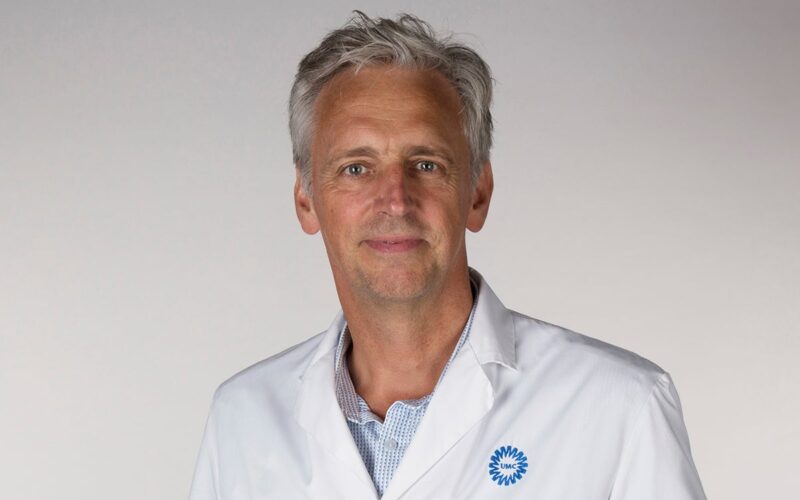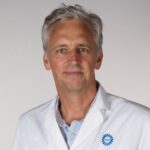Close relatives of someone with a hereditary heart disease usually have a fifty percent chance of having the predisposition themselves. Those who are aware can get regular check-ups to prevent serious consequences as much as possible. However, many people do not get tested. Prof. Dr. Peter van Tintelen and his research team explore why and what could be the causes of a hereditary heart diseases to manifest.
Peter van Tintelen is a professor of cardiogenetics at UMC Utrecht. He notes that only forty percent of first-degree relatives of patients with a heart muscle disease undergo DNA testing for possible mutations. “That leaves sixty percent who do not,” Peter expresses. “That’s unfortunate, because by regularly monitoring people with this DNA defect, giving advice and treating them if necessary, consequences such as sudden cardiac death can be prevented.”
An informed choice with the DNA clinic
“Of course we hope that this forty percent will increase, but more importantly, we want people to make an informed choice about whether or not to get tested.” Peter first investigated the reasons why family members do not get their DNA tested. It turned out that many do not get tested due to various misconceptions. For example, they consider themselves too young or prefer not to know because they think it might affect their ability to get insurance. It’s also often not seen as a priority.
“That’s why we introduced the DNA clinic. The DNA clinic is an online environment to which family members are referred through the first patient in the family, the so-called index patient,” explains Peter. “In the past, this index patient would only provide a brief letter for close family members, but now family members can find a lot of information in the online environment. For example about the disease, its heredity, and the pros and cons of a DNA test. The aim is to help healthy family members make a well-informed decision about testing based on accurate and correct information.”
Currently, researchers are conducting a clinical trial to assess the effect of this DNA clinic. This means that a group of family members goes through the DNA clinic as soon as a hereditary heart disease is diagnosed in an index patient. This group is compared with a group of family members who follow the usual care path. So far, the responses have been positive, but more people need to be involved in this research before the DNA clinic can be made available to everyone. Eventually, Peter would like to use this platform more broadly in the Netherlands and expand it for other hereditary diseases, such as hereditary cancer.
Environmental effects on heart muscle disease
Another area of focus for Peter is the impact of the environment on hereditary heart diseases. “One in 250 people has a DNA defect that can lead to heart disease. However, how it manifests can vary greatly,” says Peter. “It could be that the grandchild dies while running at the age of twenty, while the mother at fifty still has no symptoms, and the grandfather at eighty only has mild heart rhythm disorders. What makes this condition have much more severe consequences for one person than for another? Environmental factors such as noise pollution, particulate matter, or agricultural pesticides could play a role.”
Together with researchers from the group of Roel Vermeulen at Utrecht University, they conducted a small pilot study for a phospholamban mutation (PLN mutation), a genetic abnormality that causes heart muscle disease. A potential influence of environmental factors was evident. “People with the PLN mutation who live in areas with more particulate matter may have a higher chance of developing the associated heart muscle disease. To gather more evidence, we would like to expand this to a larger patient group, and we are currently seeking funding for this,” Peter shares.
Causes of atrial fibrillation
In research on atrial fibrillation, they are looking more extensively at the influence of environmental factors. In collaboration with other research groups in the Netherlands, a new study, “CIRCULAR,” has started about the causes of atrial fibrillation (the rapid contraction of the atria in your heart). “One of the goals of this study is to involve patients closely and shape the research together with them,” explains Peter. “We asked a patient group: what do you still want answered? From this, the research emerged on the influence of stress, diet, allergy medications, hereditary factors, and environmental factors (pesticides) on atrial fibrillation.”
If you experience atrial fibrillation at a young age or if it occurs frequently in your family, it’s likely that a hereditary predisposition contributes to this. Therefore, part of this study is to identify which types of hereditary predisposition underlie atrial fibrillation. Peter describes the two ways this is being done. “First, we look back at young patients who were once referred to our genetics department. The next step is to do ‘whole genome sequencing’ for patients with atrial fibrillation at a young age or familial atrial fibrillation. With this technique, we can conduct extensive genetic research and map all the DNA building blocks that are important in the development of the disease.”
“Combined with research on environmental factors, we hope to predict more accurately in the future whether and how a hereditary abnormality will manifest. Suppose you have a predisposition for a hereditary heart disease and you have additional risk factors, for example from the environment, then the chances are much greater that you will experience it at a young age. Then, monitoring can be adjusted accordingly.”
“We hope to predict more accurately in the future whether and how a hereditary abnormality will manifest'”
Customized care for each patient
In collaboration with dr. Anneline te Riele, cardiologist, and her research team, Peter has launched a new study to create more customized care for patients and family members to ensure the most effective use of care. “If we understand which factors contribute to the early manifestation of cardiomyopathies, we can anticipate them,” predicts Peter. “Currently, everyone with a genetic predisposition who has not yet shown symptoms comes in for a check-up every three years. However, we could check those at higher risk more frequently, and perhaps those without additional risk factors less often. As soon as we see signs of the disease during these check-ups, we start treatment. And the earlier we treat, the more favorable the outcome. This approach will greatly relieve both patients and cardiologists.”

